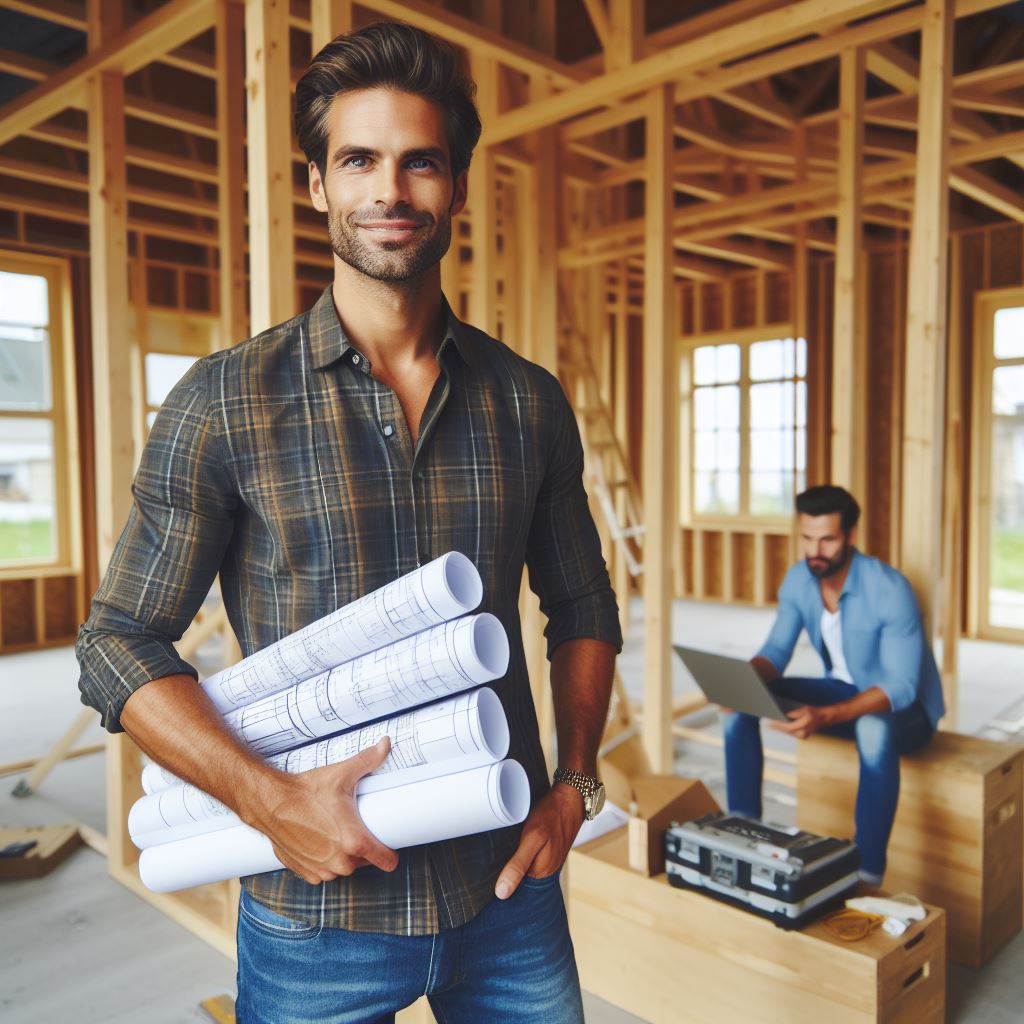Introduction
Building sustainably has become a paramount concern in the construction industry, with eco-friendly practices at the forefront.
This post delves into the fundamental aspects of eco-friendly building, emphasizing the crucial role of adhering to permits and codes in ensuring the success of environmentally conscious construction projects.
Eco-friendly building, also known as green building, refers to the practice of designing, constructing, and operating structures that prioritize resource efficiency, energy conservation, and environmental responsibility.
Such buildings aim to minimize their impact on the environment throughout their lifecycle, from design and construction to operation and eventual decommissioning.
Key elements of eco-friendly building include the use of sustainable materials, energy-efficient systems, waste reduction, and a focus on the overall ecological footprint.
By employing innovative technologies and adopting environmentally friendly practices, these structures contribute to a more sustainable and resilient future.
Adhering to permits and codes is a cornerstone of eco-friendly building, ensuring that sustainable structures meet regulatory standards and uphold environmental stewardship.
Permits serve as official authorization from local authorities, allowing construction to proceed in compliance with established guidelines.
Codes, on the other hand, are specific regulations that address safety, energy efficiency, and environmental considerations.
Compliance with permits and codes is essential for several reasons.
Firstly, it helps guarantee the safety of occupants and the surrounding community by ensuring that structures meet structural, electrical, and fire safety standards.
Secondly, adherence to codes promotes energy efficiency, reducing the overall environmental impact of a building.
Lastly, it facilitates the incorporation of sustainable practices into construction, ensuring that eco-friendly principles are woven into the fabric of the project.
In fact, understanding the definition of eco-friendly building and recognizing the importance of adhering to permits and codes are crucial steps toward creating sustainable structures.
The synergy between environmentally conscious design and regulatory compliance paves the way for a greener and more resilient future in the construction industry.
Read: Historic Districts: Special Renovation Rules
Permits for Eco-Friendly Building
Obtaining permits for eco-friendly building projects requires navigating through different agencies and regulations.
Understanding the permit process is essential for successfully implementing sustainable construction practices.
Overview of the Permit Process
Before commencing any eco-friendly building project, it is crucial to understand the permit process.
Permits are legal documents that grant permission to carry out construction, renovation, or alteration activities.
By obtaining the necessary permits, builders ensure compliance with local building codes and regulations.
Going through the permit process helps maintain strict standards that contribute to energy efficiency, sustainable design, and reduced environmental impact.
It is a critical step towards achieving eco-friendly goals and ensuring the project aligns with environmental considerations.
Specific Permits Required for Eco-Friendly Building
To facilitate eco-friendly building, there are specific permits that individuals or organizations must obtain.
These permits address various aspects of sustainable construction:
- Building permits: Obtaining a building permit is mandatory for any construction project. It ensures that the structure complies with safety standards, building codes, and guidelines for energy efficiency.
- Zoning permits: Zoning regulations define land-use requirements and designate specific areas for residential, commercial, or industrial use. Zoning permits ensure that eco-friendly projects adhere to these regulations.
- Environmental permits: Environmental permits focus on mitigating potential harm to natural resources and habitats caused by building activities. They assess the ecological impact, including protection of trees, water bodies, and wildlife habitats.
How to Obtain Permits
Now that we understand the permits required for eco-friendly building, let’s explore the process of obtaining them:
Identifying the Appropriate Permitting Agencies
Research and identify the governing bodies or agencies responsible for issuing permits in your locality.
Contact them to inquire about specific requirements and procedures.
Submitting the Necessary Documentation
Prepare detailed plans, including architectural designs, site plans, and environmental impact assessments.
These documents provide essential information that the permitting agencies require for assessment.
Paying Permit Fees
Permit fees vary based on the scope and scale of the project.
Ensure you budget for these fees and submit payment along with the required documentation.
Payment is typically made to the relevant government agency responsible for issuing the permits.
Successfully obtaining permits involves careful preparation, adherence to regulations, and coordination with the permitting agencies.
It is crucial to allow sufficient time for the permit approval process, as it may vary in duration depending on local factors.
In short, acquiring permits for eco-friendly building projects is a crucial step in ensuring compliance with regulations, promoting sustainability, and protecting the environment.
Understanding the permit process, specific permits required, and the necessary steps to obtain them are essential for success in eco-friendly construction.
Read: Living Room Revival: Stylish Renovation Tales

Codes for Eco-Friendly Building
Building codes are essential for the success of eco-friendly construction projects.
They serve as a set of guidelines and regulations that ensure buildings are constructed in a safe and sustainable manner.
Compliance with these codes is crucial to achieve energy efficiency, water conservation, and reduced environmental impact.
Let’s explore the significance of building codes and some of the prominent green building codes and standards.
Significance of building codes
- Building codes play a crucial role in ensuring the safety and sustainability of eco-friendly buildings. They provide guidelines for construction practices, materials, and design. Without these codes, there would be no standardization, leading to potential hazards and inefficiencies.
- Green building codes specifically focus on eco-friendly practices. By adhering to these codes, architects and contractors can ensure their projects minimize harm to the environment and maximize energy efficiency.
- Building codes help promote energy efficiency, water conservation, and reduced environmental impact. They encourage the use of renewable energy sources, efficient insulation, and water-saving fixtures, among other environmentally friendly measures.
Green building codes and standards
- Leadership in Energy and Environmental Design (LEED) is one of the most well-known green building certification programs. It rewards buildings that meet certain environmental criteria, such as energy efficiency, water conservation, and sustainable materials.
- The International Green Construction Code (IgCC) provides a comprehensive set of requirements for constructing sustainable buildings. It addresses areas such as site development, materials, energy usage, water efficiency, and indoor environmental quality.
- The Energy Conservation Code sets standards for energy efficiency in building design and construction. It focuses on reducing energy consumption and promoting the use of renewable energy sources.
Compliance with codes
- Architects, contractors, and inspectors play vital roles in ensuring compliance with building codes. They must familiarize themselves with the applicable codes and ensure all aspects of construction meet the required standards.
- The integration of eco-friendly features into building plans is essential to meet code requirements. Design considerations should include energy-efficient systems, sustainable materials, and proper waste management strategies.
- Ensuring proper construction techniques is crucial to achieving the desired environmental performance. Contractors and inspectors must oversee the construction process to verify that eco-friendly practices are implemented correctly.
In a nutshell, building codes are a key factor in the success of eco-friendly building projects.
They not only ensure the safety and sustainability of structures but also drive energy efficiency and environmental responsibility.
By complying with green building codes and standards, architects, contractors, and inspectors contribute to the development of a more sustainable built environment.
Read: Commercial vs. Residential Permits Explained
See Related Content: Green Building Materials: What’s Trending?
Benefits and Challenges of Adhering to Permits and Codes
When it comes to environmentally conscious construction, following permits and codes is crucial.
By doing so, builders and developers gain various advantages that positively impact both the environment and their bottom line.
Benefits of following permits and codes
- Environmental sustainability: Adhering to permits and codes ensures that eco-friendly buildings are constructed, minimizing their environmental footprint. These regulations often include guidelines for energy efficiency, water conservation, and waste management. By complying with these regulations, builders contribute to reducing overall carbon emissions and preserving natural resources.
- Energy efficiency and cost savings: One of the significant benefits of adhering to permits and codes is the creation of energy-efficient buildings. These regulations require the use of sustainable materials, proper insulation, and efficient appliances, among other specifications. As a result, eco-friendly buildings consume less energy, leading to lower utility bills for both homeowners and commercial property owners. Additionally, energy-efficient buildings often require less maintenance and repair, resulting in long-term cost savings.
- Enhanced property value and marketability: Buildings constructed in compliance with permits and codes tend to have higher market value. Homebuyers, renters, and investors are increasingly prioritizing sustainable features and practices when selecting properties. By following these regulations, builders increase their property’s appeal and marketability. Eco-friendly buildings often attract a wider range of environmentally conscious buyers and tenants, leading to quicker sales or rentals and potentially higher profits.
Challenges of compliance
While the benefits of adhering to permits and codes are compelling, there are certain challenges to consider when striving for compliance.
- Higher upfront costs: Constructing eco-friendly buildings that comply with permits and codes may initially come with higher upfront costs due to the use of specialized materials, technologies, and design considerations. However, the long-term energy savings and increased property value can offset these initial expenses.
- Limited availability of eco-friendly materials: Another challenge is the limited availability of eco-friendly materials that meet the strict requirements of permits and codes. Finding suitable alternatives to conventional construction materials can be time-consuming and costlier. However, as demand for sustainable materials increases, their availability is expected to improve, and costs may eventually decline.
- Technical complexity and lack of expertise: Adhering to permits and codes often involves technical complexity that requires specialized knowledge and skills. Builders and contractors may face challenges in acquiring the necessary expertise to incorporate eco-friendly features effectively. Collaborating with experienced architects, engineers, and green building consultants can help overcome these obstacles and ensure compliance.
All in all, the benefits of following permits and codes for eco-friendly building outweigh the associated challenges.
Environmental sustainability, energy efficiency, cost savings, enhanced property value, and marketability are some of the key advantages.
Despite the challenges of higher upfront costs, limited availability of materials, and technical complexity, the long-term benefits make it worthwhile to adhere to these regulations.
By embracing environmentally conscious construction practices, builders contribute to a greener future and create more sustainable communities.
Read: DIY Renovation? Know Your Permit Needs
Conclusion
In the realm of eco-friendly building, obtaining permits and adhering to building codes isn’t just a bureaucratic hurdle—it’s a cornerstone of sustainable construction.
Permits ensure that your eco-friendly building project aligns with local environmental regulations, safety standards, and energy efficiency guidelines.
They serve as a safeguard against potential hazards and unauthorized construction, fostering a balance between innovation and responsibility.
Adhering to codes is crucial for maintaining the integrity of eco-friendly structures.
From solar installations to rainwater harvesting systems, codes provide a framework that ensures these features are designed and implemented with precision.
This not only guarantees the safety of occupants but also maximizes the efficiency of green technologies, ultimately contributing to a more sustainable future.
Furthermore, permits and codes promote transparency and accountability in the construction process.
By obtaining the necessary approvals, builders signal their commitment to environmental responsibility.
This not only enhances the reputation of the project but also establishes a precedent for future sustainable developments.
It sends a powerful message that eco-friendly building isn’t just a trend but a conscientious choice to build with the planet in mind.
As the world grapples with environmental challenges, the role of real estate developers and homeowners in fostering sustainable construction practices becomes paramount.
Embracing eco-friendly building methods isn’t just an ethical choice—it’s a strategic one.
Beyond the immediate benefits of reduced environmental impact, sustainable buildings often enjoy increased market value and lower operational costs, providing a compelling case for long-term investment.




